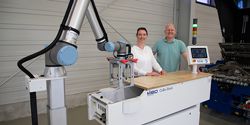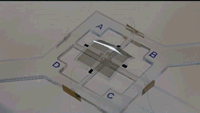Linear Actuators vs Rotary Actuators: The Core Choice for Humanoid Robot Joints
The robot joint module is the core hardware of humanoid robots, currently mainly divided into two major categories: rotary and linear. In humanoid robot designs, the choice often involves trade-offs based on the application scenario and manufacturing cost.
Rugged electric actuators provide reliable steering for extensible, self-driving platform
Whether OxDrive's next application is in agritech, construction, forestry, warehouse logistics or any other untapped use, chances are good that it will need a reliable actuator. And when it does, Horton will likely continue specifying Thomson linear motion solutions.
Joint actuators: The fundamental component for humanoid robots' power and dexterity
Although there are structural similarities between humanoid robot joints and collaborative robot joints, there are still many differentiated requirements that pose higher performance demands.
Actuator Technology in Robotics Applications
LINAK offers easy integration with robotics applications through CANOpen. Our DC actuators match up with battery voltage to provide the complete linear motion system.
What Are the Differences Between Linear and Rotary Actuators?
Depending on the nature of the output motion, actuators can be divided into linear and rotary. Each of these is available in different versions and configurations that help deliver the desired outcome.
10 Different Options For Controlling Linear Actuators
Below you will find ten different options for controlling linear actuators. This list is intended to give you an overview of what's possible for linear actuator control. It's not exhaustive, there are other options, but these are the ones that will work for most people.
Acting Like a Muscle, Nano-Sized Device Lifts 165 Times its Own Weight
Rutgers University-New Brunswick engineers have discovered a simple, economical way to make a nano-sized device that can match the friendly neighborhood Avenger, on a much smaller scale. Their creation weighs 1.6 milligrams (about as much as five poppy seeds) and can lift 265 milligrams (the weight of about 825 poppy seeds) hundreds of times in a row.
Artificial muscle for soft robotics: Low voltage, high hopes
Phys.org: Soft robots do a lot of things well but they're not exactly known for their speed. The artificial muscles that move soft robots, called actuators, tend to rely on hydraulics or pneumatics, which are slow to respond and difficult to store.
Dielectric elastomers, soft materials that have good insulating properties, could offer an alternative to pneumatic actuators but they currently require complex and inefficient circuitry to deliver high voltage as well as rigid components to maintain their form—both of which defeat the purpose of a soft robot.
Now, researchers at the Harvard John A. Paulson School of Engineering and Applied Sciences (SEAS) have developed a dielectric elastomer with a broad range of motion that requires relatively low voltage and no rigid components. They published their work recently in Advanced Materials. Cont'd...
Types of Robotic Actuators
Actuators have become a crucial part of the automated system, as they help with controlling equipment using hydraulic, pneumatic or in some of the cases electronic signals.
Case Study: Validated High Speed Capping
SMACs LAR Series linear-rotary actuators provide the ideal technology for improving capping quality while cost-effectively providing 100% real time on- and off-torquing validation.
Records 1 to 10 of 10
Featured Product

BTM Industrial -The industry leader in assisting companies with surplus assets.
BTM Industrial is a leading asset disposition company assisting manufacturing companies with their surplus asset needs. Founded in 2011, it is a fully licensed-and-regulated, commission-based auction and liquidation company. The company's full asset disposition programs provide customers with the ability to efficiently manage all aspects of their surplus and achieve higher value.
Robotics and Automation - Featured Company

Harmonic Drive LLC
Harmonic Drive LLC (HDLLC) designs and manufactures precision servo actuators, gearheads and gear components. Harmonic Drive® gears play critical roles in robotics, medical diagnostics and surgical robotics. We work with industry-leading customers and companies of all sizes to provide both standard product and custom-engineered solutions. The majority of the products sold by HDLLC are proudly made at our US headquarters and manufacturing facility in Massachusetts.









.jpg)
